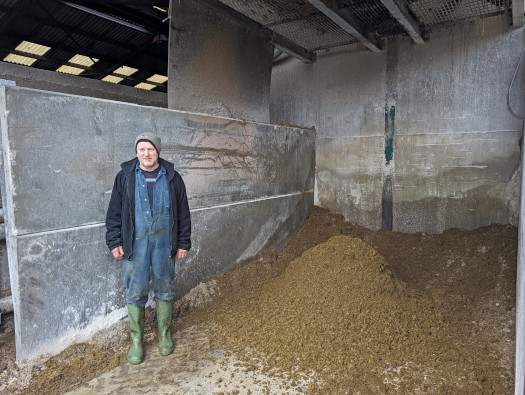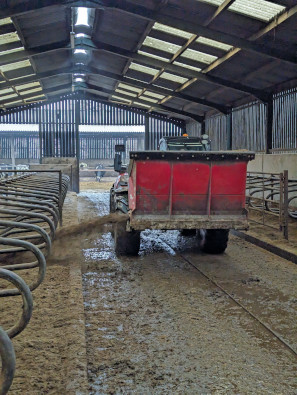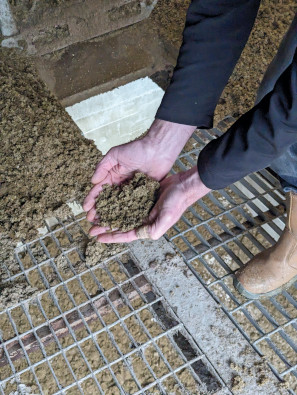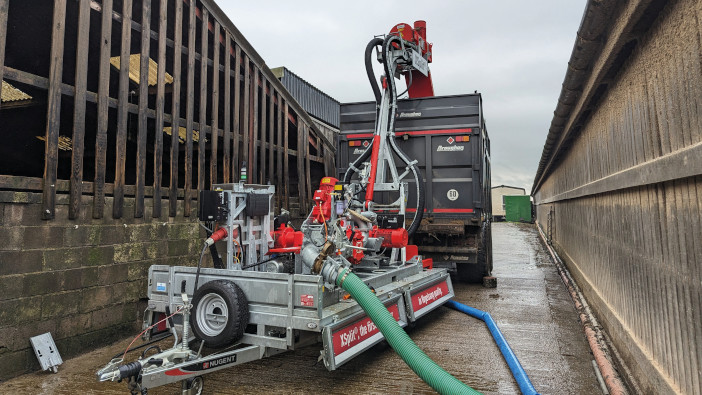As conversations continue to intensify around the use and storage of slurry, Matthew Tilt headed up to Lancashire to see how a Vogelsang separator has helped a dairy farm handle its organic nutrients.
J & M Singleton & Sons has used green bedding for eight years, bedding down 250 pedigree Holstein milkers, as well as followers. It’s run by three brothers, James, Colin and Andrew Singleton, with a substantial covered slurry store fed by the wet cows.
“We first looked at using separated slurry dry matter as bedding to counteract the cost of using sawdust,” explained James. “At the same time, sawdust had risen to around £100 per day and by our calculations, separating the slurry works out at around £6 per day. The difference is stark, even more so now that sawdust has continued to rise.”
As well as a clear cost benefit, there were also positives in regard to animal health. For starters, as the system is now a circular process, there are no longer limits on how much bedding is applied – this means a deeper, more comfortable bed for the cows to lay on. Through regular vet visits, they have also seen a reduction in mastitis, as well as an improvement in the air quality throughout the sheds as there is almost no dust.

The Singletons separator is mounted on a gantry next to the slurry store, expelling solids into a bunker below 
James Singleton
The only additional cost has been a small amount of lime mixed into the separated dry matter to neutralise the pH levels. James noted that they use around 250kg of lime for every five to six tonnes of green bedding. “We can still use the same bedding equipment as we did previously, so there has been no capital investment beyond the separator itself and some minor infrastructure changes to keep it running.”
The green bedding is cleared daily and respread, with the old bedding making its way back into the slurry pit and back through the separation system. “Through each process, the molecules get smaller and smaller until eventually they are completely absorbed into the slurry.”
While the Singletons had previously used a different brand, they now have a Vogelsang XSplit model, mounted on its own gantry next to the slurry store. Capable of producing a separated product with up to 40% dry matter, it’s a press screw system with sieves to separate the dry content from the slurry liquor.
“We get an average throughput of around 40m3 an hour, depending on the consistency of the slurry,” explained James. “And it’s a cost-effective system as the only wearing parts are the three sieves and the leading flight on the auger.”

As the slurry is a corrosive material, these wearing parts are put through the wringer, and since purchasing the separator, James noted that they have seen a proactive stance from Vogelsang when it comes to updating and adjusting the XSplit to deal with the rigours of daily use.
“Since we’ve been using the XSplit, Vogelsang have uprated the central screens so that they last a lot longer and are looking at strengthening the auger flight so that it can last closer to 2,000 hours.”
A notable point about the Vogelsang system is that the 5.5kW motor is mounted at the dry outlet, preventing any major maintenance issues as the liquid cannot enter the drive system.
According to James, the benefits of moving to separated slurry haven’t just stopped at having a sustainable, near-unlimited source of cattle bedding. Having a covered slurry store puts a very inflexible limit on the capacity – even without the rain infiltration that uncovered lagoons have struggled with this season – and running the separator for just a few hours a day has helped the farm keep the store well within this.
It’s also reduced the amount of work that goes into handling the slurry. The resulting liquor after separation is more homogenous and does not form a crust, so stirring is done with a small 1.5kW paddle unit. When it comes time to spread, it’s a far less intensive process to pump the slurry either to a tank or through an umbilical system.
Vogelsang states that the nutrients available in the slurry become more available once the dry matter has been removed. Nitrogen is more prevalent in the liquor, whereas phosphate and potassium are part of the makeup of the solid matter. This enables farms to better adjust their nutrient application plans based on legislation and plant needs.

Demonstrating the XSplit
Heading over to another local farm, we had the opportunity to see a demonstration XSplit in action. Vogelsang’s demonstration unit is mounted on a trailer with lobe pumps at the inlet and outlet of the separator and a RotaCut macerator. There’s also a debris catcher fitted, which the company states is ideal for separating foreign objects and avoiding damage throughout the system.
This is pertinent when the slurry store is uncovered, where litter and other objects can find their way into the lagoon, or if the lagoon has not been fully emptied in a long time – as foreign objects from years before can find themselves buried at the bottom.
This second farm reiterates the possibility of slurry based on the nutrient requirements of the business. This farm’s concern was around the phosphate load within the slurry and so was examining the possibilities of separating and exporting the solid contents off-farm.
Slurry separation technology, including the Vogelsang XSplit, is eligible for a Farming Equipment and Technology Fund (FETF) 2024 grant. Up to £50,000 is available for slurry technology.
The latest round of applications closed on the 17th of April, with two more application windows expected later this year.
You can apply at www.rpagrants.org.uk. For more information on the XSplit go to www.vogelsang.info


